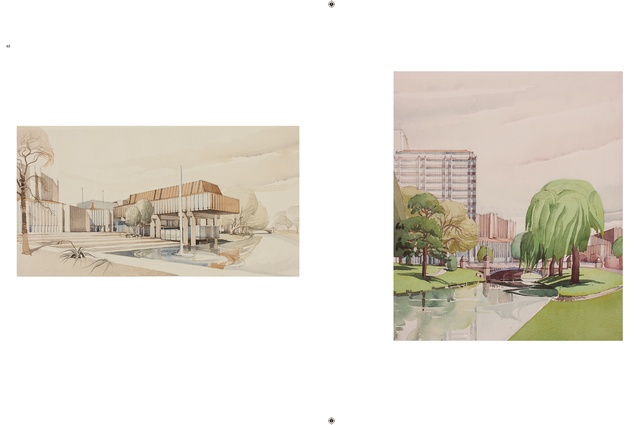Review: The Christchurch Town Hall 1965–2019: A Dream Renewed
University of Melbourne professor of architecture Paul Walker reviews this book, edited by Ian Lochhead, that explores the design of an iconic New Zealand building.
This book is a record of the design and construction of one of New Zealand’s most accomplished public buildings, the campaign to save it after the Canterbury earthquakes of 2010–2011, and the attendant political and technical challenges of its reconstruction. It is a significant publication: firstly, a reminder that Warren and Mahoney’s Town Hall was one of the finest achievements of the ‘Christchurch School’ and, secondly, a celebration of its rehabilitation and return to a central place in the city’s civic life. It coincides with a sense that the rebuilding of Christchurch has turned a corner: not so much a recovery of the old city but progress towards the beginning of a new vitality. Fingers crossed.
The contributors include key participants in the original design of the Town Hall, Miles Warren and the acoustician Harold Marshall, and two of those chiefly responsible for its rehabilitation and re-engineering, Peter Marshall – a principal in Warren and Mahoney now – and the engineer John Hare who led the Holmes Consulting team that completed the post-earthquake structural assessment and engineering work. The book also features a selection of drawings of the building’s original design and three groups of photographs: of the building as completed in 1972, of the reconstruction work (by Olivia Spencer-Bower) and, by Duncan Shaw-Brown, of the renewed Town Hall complete. There is also a chapter on the history of the Town Hall’s organ.
These materials are given coherent shape by the architectural historian and heritage expert Ian Lochhead, who edited the volume and contributed an introduction tracing the protracted history that led to the 1966 design competition for the Town Hall, chapters on the competition and its outcome and on the Town Hall’s role in Christchurch’s civic life, and an afterword. Lochhead was one of the leaders of the campaign to save the building in the face of opposition from the Minister for Canterbury Earthquake Recovery, Gerry Brownlee, and so the book is, also, a celebration of a success for advocacy and expertise in opposition to ignorant authority.
The book is an impeccable object: square format, generous margins, elegant fonts. The design, however, is conservative. Does this reflect the reasons for which the building is significant? When the Christchurch Town Hall was completed, it was mostly lauded and deservedly so. But, as Lochhead mentions, the journal Designscape was cool, its anonymous review of the building describing it as “logical, cohesive, scholarly to the point of being pedantic, quite traditional, civilised, permanent, authoritative and rather pompous despite its intimate scale. In all these qualities, it exactly mirrors Christchurch and its Establishment outlook…”
This was a projection of a caricature of Christchurch common enough in New Zealand, but at odds with the city’s history of working-class politics; when Christchurch resolved to build the town hall and held the competition for its design, its popular and long-serving mayor was the former union activist and Labour Party member George Manning. Was he supportive of the Town Hall project, or opposed? Christchurch’s most prominent politician in 1972 was the Labour Party leader and MP for Sydenham, Norman Kirk.
Nevertheless, the city’s putatively conservative outlook was apparent at the Town Hall’s original opening, with a concert of classical music and a performance in the James Hay Theatre of Shakespeare’s Henry V.
A brass band contribution perhaps acknowledged some sort of inclusiveness. But, as Lochhead notes (p. 115), “From the perspective of the twenty-first century, however, the opening events were marked by the overwhelming dominance of western cultural values and the absence of any expression of Māori culture or recognition of Ngāi Tahu’s longstanding connection with the site.” I fear that similar exclusions apply in this book. The Town Hall was so important precisely because of the sense – to use Lochhead’s term – that it served as the city’s ‘Living Room’. And yet the dominant voices in this volume are those of the accomplished professionals who made and remade the physical fabric of the building.
Two of the chapters – those by Miles Warren and Harold Marshall – have previously been published. What has been notable about the lobbying for Christchurch’s heritage and its post-earthquake future has been the role of people like Barnaby Bennett and Jessica Halliday alongside more traditional heritage advocates. Both were heavily involved with Lochhead and others in the Keep Our Town Hall lobby group (acknowledged p. 10). I would very much like to have read what they might have had to say about the Town Hall and its place in the re-emerging city. I would like to have read the thoughts of community activists, Ngāi Tahu and the young. About the organ – not so much.
The Christchurch Town Hall 1965–2019: A Dream Renewed can be purchased online here.











